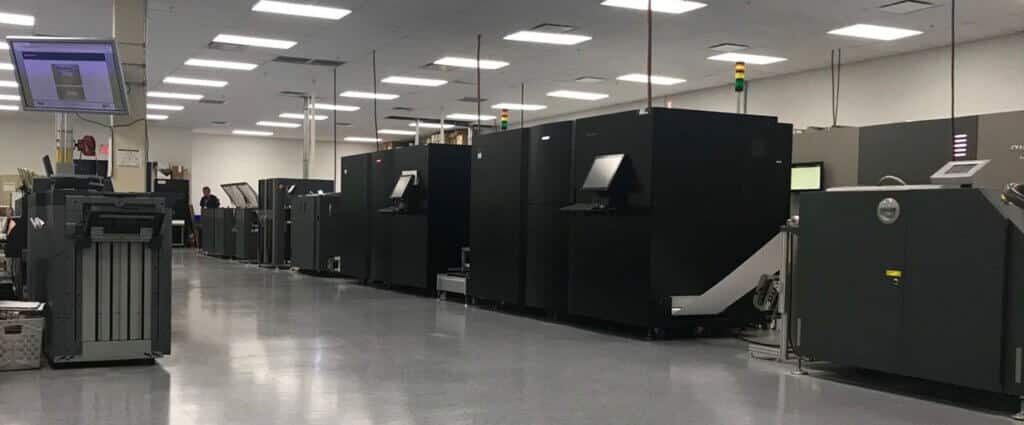For more organizations, print and mail outsourcing offers an increasingly attractive alternative to the cumbersome and costly reality of managing in-house printing and mailing operations.
Building and maintaining an internal print and mail infrastructure might seem practical if your organization has a high volume of outbound mail, but the truth is in-house plants can be a significant drain on resources, hindering efficiency and growth. When businesses outsource printing and mailing, they gain a range of advantages, from streamlining operations and enhancing compliance to improving the bottom line.
The true cost of in-house printing and mailing
The initial purchase of printing and mailing equipment and associated software is just the tip of the iceberg when considering the cost of an in-plant operation. Add in specialized repairs, depreciation, equipment upgrades every five years, physical servers to store data, paper, ink and other supplies and storage. Employees with skills to manage printing and mailing tasks are another sizable expense. Plus, the equipment consumes significant energy and space, further increasing operational costs.
A torrent of transactional communications
Despite a major shift to digital communications, the volume of transactional mailings in the United States is substantial.
A 2022 survey by Keypoint Intelligence found that 43% of transactional communications to consumers was sent by mail. One in four companies print and mail more than 10 million transactional communications annually, according to the research. This figure encompasses a wide range of communications, from bills and statements, payment reminders, notices and regulated correspondence such as adverse action letters.
Managing this volume internally presents a significant logistical challenge for mid-sized to large businesses.
The benefits of print and mail outsourcing

Partnering with a best-in-class provider can ensure companies retain control over their communications streams while enjoying more agility to meet changing corporate and consumer requirements. When companies outsource printing and mailing, they move to a variable-cost business model, allowing them to expand and contract volume as needed without worrying about covering high fixed costs.
Here is a closer look at some key upsides:
1. Cost effectiveness
Clients benefit from lower per-unit costs when print and mail service providers leverage their economies of scale. They can purchase large quantities of paper, ink, envelopes and other supplies at significantly lower costs than many individual businesses can, for example.
Due to their high volume, print and mail providers also use presorting automation and receive bulk discounts to secure lower postage rates for their clients. With USPS recently implementing some of the largest rate increases in history, businesses need to secure every advantage.
Outsourcing further reduces expenses compared to in-plant operations by eliminating the need for in-house maintenance, IT support, dedicated staff, and hard to find skilled equipment operators.
2. Efficiency and productivity
Managing an in-plant operation is complex and time-consuming. Print and mail outsourcing frees the internal team from redundant, error-prone tasks, allowing redeployment to higher-value assignments focusing on core business activities.
Outsourcing partners with the latest technology and techniques can streamline the entire process. High-speed, dynamic variable color printers and inserters automate and accelerate production. Some providers run data files through the National Change of Address database (NCOA), CASS™ Certification and Delivery Point Validation (DPV) to identify outdated addresses and improve mail delivery rates. Outsourcing partners may also offer advanced services, including address change, skip tracing, return mail and automated Certified Mail services.
3. Expertise and innovation
The leaders among print and mail outsourcing providers bring best practices and innovation, enabling clients to transform their customer communications to enhance experience and effectiveness. They invest in the most up-to-date printing and mailing technologies, including roll-fed color inkjet printers that print up to 1,000 pages per minute, with in-line finishing, variable data and real-time personalization. Advances in ink chemistry, printhead technology, dryers, lightning-fast inserters, folding machines, and more combine to ensure superior quality output, consistency and production.
It’s vital that companies look beyond even the most advanced printing and mailing services, however. What’s needed are print and mail outsourcing partners that offer cloud-based automated solutions and customer communication management systems. These cloud platforms to create and customize customer documents should integrate into the production and mailing workflow, accept APIs and multiple data formats, and be accessible in the office or remotely. The integrated approach results in greater control, faster turnaround times, improved accuracy, and increased efficiency.
4. Scalability and flexibility
Cost-effectively managing fluctuating production and mail volumes can be challenging with in-house equipment. Outsourcing gives organizations the flexibility to scale print and mail operations up or down as needed, eliminating additional technology investment and costs. This is particularly beneficial for businesses that experience seasonal fluctuations or unpredictable demand.
5. Security and business continuity
Top print and mail outsourcing providers prioritize data security and business continuity, in turn supporting their clients in staying current and compliant.
Companies serious about security work with highly regulated industries and train staff so they stay up-to-date on secure data handling requirements. These outsourcers meet and maintain the strictest data security, regulatory and compliance requirements, verifiable through regular audits for HIPAA and SOC2 Type 2 compliance.
They also have robust business continuity plans in place. These contingencies ensure sensitive information is protected and communications remain unaffected in the event of business disruption, including natural disasters, fire, flood, power outage, pandemic and unforeseen circumstances. For a higher level of confidence, look for a provider with fully redundant operations in geographically disparate locations.
6. Reporting and visibility
Many outsourcing providers offer detailed reporting and tracking tools so organizations can monitor and gain insights into their print and mail performance. Some automatically feed KPIs and reports into an integrated CCM system and allow companies to digitally organize and archive printed communications in the cloud. For the archives, companies can set their own retention lengths to meet regulatory requirements, while quick communications retrieval options allow customer service staff to pull up documents instantly and give customers self-service access via a secure online portal.
Measuring ROI: A data-driven approach
Companies can quantify the positive impact of print and mail outsourcing on their business by analyzing key metrics. Here are some essential metrics to track:
- Cost per mail piece: Compare in-house to outsourced costs to assess savings.
- Turnaround time: Track the time it takes to complete printing and mailing tasks internally and with an outsourced provider.
- Accuracy: Measure the rate of errors in mailings before and after outsourcing.
- Employee productivity: Evaluate the amount of time the internal team saves by outsourcing print and mail tasks.
- Customer satisfaction: Track customer feedback on the timeliness and quality of mailings.
By monitoring these metrics, companies can gain valuable insights into their print and mail provider’s program execution and demonstrate the positive impact on the overall business performance.
Embracing the future of print and mail
Outsourcing print and mail services is a strategic necessity for organizations seeking to optimize operations and reduce costs. Leveraging a provider’s advanced CCM platform to compose and personalize communications also can open up omnichannel delivery options, including email, mobile and text messaging distribution, to meet consumer expectations and enhance customer experience and engagement.
Are you ready to explore the potential of print and mail outsourcing? Contact us to learn how Nordis Technologies can transform your print and mail operations and future-proof your organization’s customer communication strategy.





